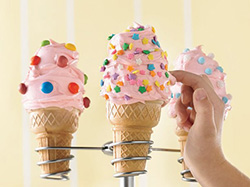You want your child to be safe and sound as you travel with him in your vehicle each day. What you may not know is that every year thousands of children are injured or killed in car crashes. Many of these deaths and injuries could have been avoided if children were properly secured in their car safety seats or seat belts. You can make a difference for your child by using their car seats or seat belts properly every time they ride in your car.
How to Choose and Use
Choose a car seat based on your child’s age, weight and size. Try it out in the store before you take it home. Place your child in the seat and adjust the straps and buckles to make sure it works for your child. Fit it properly and securely in your car. Ensure the seat is buckled tightly into your vehicle and your child is buckled snugly into the seat. For the best protection for your child, keep him in the seat until he has reached the manufacturer’s height or weight limit.
Rear-Facing Seats – All infants and toddlers should ride rear-facing until they are 2 years of age or until they reach the highest weight or height allowed by the manufacturer of their car safety seat. If your baby reaches the height and weight limit for his infant-only seat, he should continue to ride rear-facing in a convertible car seat for as long as possible. Check your car safety seat instructions to find the weight and height limits for rear-facing seats. Some types allow up to the weight of at least 35 pounds.
Forward-Facing Seats – Children who are 2 years or older, or who have outgrown the rear-facing weight or height limit for their car safety seat should ride in a forward-facing seat with a harness for as long as possible, up to the highest weight or height allowed by the manufacturer of their seat. Check your car safety seat instructions to find the weight and height limits for forward-facing seats. Some types allow up to a weight of 65-80 pounds.
Booster Seats – Children whose weight or height is above the forward-facing limit for their car safety seat should use a belt positioning booster seat until he is big enough to fit in a seat belt properly. Booster seats are designed to raise your child so that the lap and shoulder seat belts fit properly. The lap belt should lie low across a child’s upper thighs and the shoulder belt should cross the middle of a child’s chest and shoulder.
Seat Belts Usually between ages 8 and 12, or when they are 4’9” tall, children should use a seat belt in the rear seats of vehicles for optimal protection. The seat belt should fit properly with the lap belt lying across the child’s upper thighs and the shoulder belt across the chest. Seat belts are designed for adults. If it does not fit your child correctly, she should stay in a booster seat until the seat belt fits her properly. Also, be sure your child does not tuck the shoulder belt behind her back or under her arm.
Tips to remember
There are many types of seats that can be used. Be sure that the car safety seat you choose works within current child passenger safety guidelines. When making changes, always follow the car seat instructions. Follow the instructions in your car owner’s manual to properly install your child’s car seat. Always wear your own seat belt as a good role model. Never allow anyone to share car seats or seat belts. The safest place for children under the age of 13 is in the back seat.
All of the above information was gathered from the American Academy of Pediatrics (AAP) Website at www.aap.org and the National Highway Traffic Safety Administration (NHTSA) Website at www.nhtsa.gov. If you want more information, such as on safely securing children with special needs, premature infants, using used car seats or airplane safety tips, go to these sites. If you need help installing your child’s car seat, contact a certified Child Passenger Safety (CPS) technician. To locate a car seat inspection station and set up an appointment, call toll-free 866/SEATCHECK (866/732-8243) or visit www.seatcheck.org.
Need more child safety tips? Contact Premier Academy Today!

 We’ve bumped up the mealtime chatter in your home. We’ve ensured your little one can help safely in the kitchen – and learn a bunch in the process, too. Now, it’s time to cook! Here are two fool-proof recipes that young children love to make – and eat. From my family to yours – enjoy!
We’ve bumped up the mealtime chatter in your home. We’ve ensured your little one can help safely in the kitchen – and learn a bunch in the process, too. Now, it’s time to cook! Here are two fool-proof recipes that young children love to make – and eat. From my family to yours – enjoy! Eat your breakfast!
Eat your breakfast! There are many reasons kids should play outside, from expressing creativity to running freely to making messes without worrying about dirtying the house. In addition to these fun reasons, there are also many health benefits that make outdoor play great for children.
There are many reasons kids should play outside, from expressing creativity to running freely to making messes without worrying about dirtying the house. In addition to these fun reasons, there are also many health benefits that make outdoor play great for children. We’ve all been there. And many of us still are. No matter how many times we swore (to ourselves and everyone around us) that our kids will be different, that our kids will eat everything, the inevitable happened. We raised picky eaters. Gone are the fantasies of eating family meals of chicken salad and thai curry. Now we get excited if they eat a bite of broccoli alongside a cheesy bowl of macaroni. Chicken nuggets are their own food group, along with buttered pasta and fish.
We’ve all been there. And many of us still are. No matter how many times we swore (to ourselves and everyone around us) that our kids will be different, that our kids will eat everything, the inevitable happened. We raised picky eaters. Gone are the fantasies of eating family meals of chicken salad and thai curry. Now we get excited if they eat a bite of broccoli alongside a cheesy bowl of macaroni. Chicken nuggets are their own food group, along with buttered pasta and fish. With the winter months coming upon us, we find that our children are at risk for infections and colds. Taking care of a sick toddler isn’t fun. But taking care of two sick children is worse. It means more misery and sleepless nights — and for you, more missed days of work.
With the winter months coming upon us, we find that our children are at risk for infections and colds. Taking care of a sick toddler isn’t fun. But taking care of two sick children is worse. It means more misery and sleepless nights — and for you, more missed days of work. Infant Massage
Infant Massage